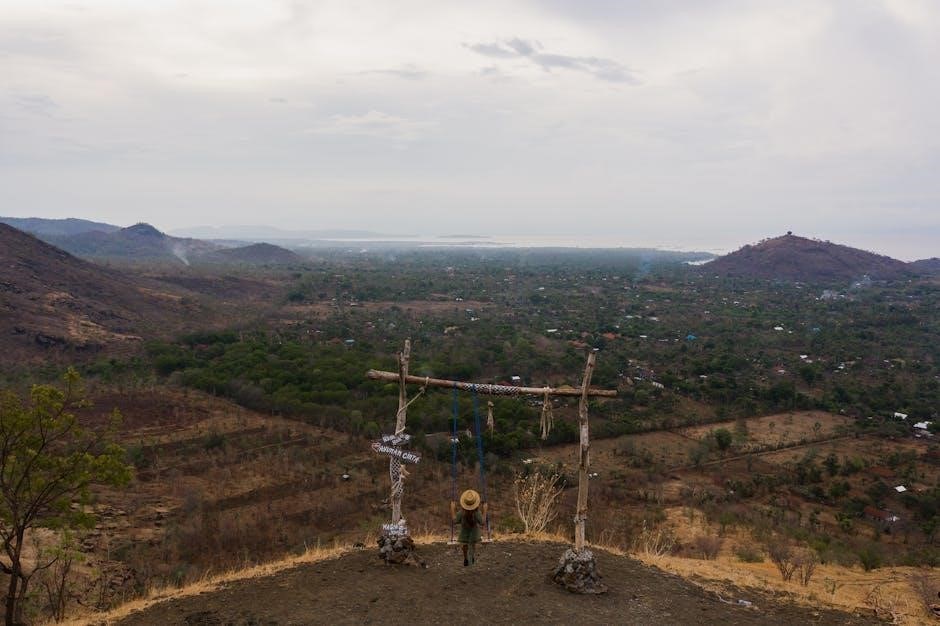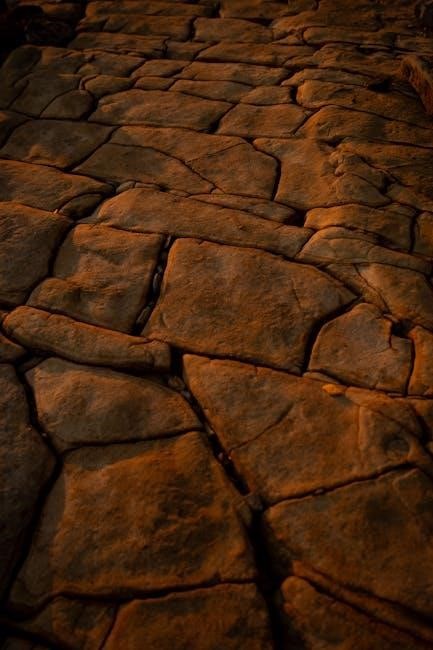Gold-bearing rocks are geological formations containing gold in economic quantities‚ often associated with quartz veins‚ sulfides‚ and alteration zones․ Accurate identification is crucial for prospectors and geologists‚ enabling efficient exploration and extraction․ Understanding key characteristics‚ such as mineral associations and structural features‚ aids in distinguishing productive deposits from barren rock․ This guide provides insights into the methods and challenges of identifying gold-bearing rocks‚ ensuring informed decision-making in mineral exploration․
Overview of Gold-Bearing Rocks
Gold-bearing rocks typically occur in quartz veins‚ sulfide-bearing environments‚ or metavolcanic formations․ Historical samples reveal gold values up to 5․0 grams per tonne and 5․5% copper․ These rocks often exhibit hydrothermal alteration‚ making identification challenging․ Quartz-carbonate veins with minor iron oxides and pyrite are common hosts․ Trace-element geochemistry‚ such as elevated Au and Ag‚ aids in recognizing mineralized zones․ Understanding these geological features is essential for effective exploration and distinguishing productive deposits from barren rock․
Importance of Accurate Identification
Accurate identification of gold-bearing rocks is critical for efficient mineral exploration and extraction․ Misidentification can lead to financial losses and resource mismanagement․ Correctly distinguishing productive deposits from barren rock ensures focused exploration efforts‚ optimizing resource allocation․ In historical gold camps‚ limited geological data exacerbates the challenge‚ making precise identification vital․ Training locals to recognize key features aids in successful prospecting‚ highlighting the importance of accurate methods and techniques in gold-bearing rock identification․
Key Characteristics of Gold-Bearing Rocks
Gold-bearing rocks often exhibit distinct geological features‚ such as quartz-carbonate veins with minor iron‚ sulfides‚ and hydrothermal alteration zones․ Pyrite-bearing rocks with fine-grained textures are common․ Stacked quartz veins in metavolcanic rocks‚ associated with sinistral shear‚ are key indicators․ Mineralization is frequently linked to zones of pervasive alteration‚ making identification challenging․ Trace-element geochemistry‚ such as elevated copper and gold values‚ further aids in recognizing prospective deposits․ These characteristics guide prospectors in distinguishing gold-bearing rocks from barren formations‚ enhancing exploration efficiency and success rates․

Types of Gold-Bearing Rocks
Gold-bearing rocks include quartz-carbonate veins‚ sulfide-bearing formations‚ and metavolcanic rocks․ Quartz veins often host gold‚ while sulfides like pyrite and arsenopyrite are common associates․ Metavolcanic terranes‚ such as those of Neoproterozoic age‚ frequently contain gold mineralization․
Quartz Veins and Their Association with Gold
Quartz veins are a primary host for gold deposits‚ often forming in fractures and fault zones․ These veins can contain high-grade gold mineralization‚ sometimes associated with sulfides like pyrite․ Historical samples show gold values up to 5․0 grams per tonne‚ with quartz-carbonate veins being particularly significant․ Stacked‚ extensional quartz veins‚ influenced by tectonic forces‚ are common in gold-bearing regions․ Their formation is linked to hydrothermal activity‚ making them key targets for exploration․ Identifying these veins requires understanding their structural and mineralogical characteristics‚ essential for successful gold prospecting and extraction efforts․
Sulfide-Bearing Rocks and Their Role in Gold Mineralization
Sulfide-bearing rocks‚ such as pyrite‚ are frequently associated with gold mineralization․ These rocks often form in hydrothermal environments‚ where gold is precipitated alongside sulfides․ Pyrite‚ in particular‚ is a common indicator mineral‚ though it can be challenging to distinguish from gold-bearing quartz veins․ The presence of sulfides like pyrite in altered zones suggests potential gold mineralization․ Identifying these sulfide-rich areas is crucial for prospectors‚ as they often indicate nearby gold deposits․ However‚ pervasive hydrothermal alteration can complicate the identification of sulfide-bearing rocks‚ making advanced analytical methods necessary for accurate assessment;
Metavolcanic Rocks as Hosts for Gold Deposits
Metavolcanic rocks are significant hosts for gold deposits‚ particularly in regions with a history of tectonic activity․ These rocks‚ often formed from ancient volcanic activity‚ provide fertile ground for gold mineralization․ Quartz-carbonate veins and sulfides are commonly found within these rocks‚ indicating potential gold-bearing zones․ The Neoproterozoic Khan metavolcanic rocks‚ for instance‚ host Au and Au-Ag mineralizations․ Stacked quartz veins in these formations are key indicators of gold deposits․ Understanding the geological context of metavolcanic rocks is essential for effective exploration and identification of gold-bearing areas‚ as they often contain high-grade ore․

Geological Indicators of Gold-Bearing Rocks
Geological indicators such as quartz veins‚ sulfide minerals‚ and alteration zones guide prospectors in identifying gold-bearing rocks‚ aiding in exploration and mineral mapping efforts effectively․
Mineral Associations and Paragenesis
Mineral associations and paragenesis play a crucial role in identifying gold-bearing rocks․ Specific minerals like pyrite‚ arsenopyrite‚ and sulfides often accompany gold deposits‚ forming predictable paragenetic sequences․ Understanding these associations helps prospectors trace gold mineralization․ For instance‚ the presence of quartz with sulfide minerals in hydrothermal veins is a strong indicator of potential gold deposits․ Analyzing the sequence of mineral formation provides insights into the geological conditions that favor gold concentration․ This knowledge enhances exploration strategies and increases the likelihood of discovering gold-bearing rock formations effectively․
Alteration Zones and Their Significance
Alteration zones are critical indicators of gold-bearing rock systems‚ representing areas where rocks have undergone chemical changes due to hydrothermal activity․ These zones often form halos around gold deposits‚ with minerals like sericite‚ chlorite‚ or kaolinite indicating alteration․ The type and intensity of alteration provide insights into the geological environment and the potential presence of gold․ Mapping these zones helps prospectors identify exploration targets and understand the spatial relationship between alteration and mineralization‚ enhancing the efficiency of gold discovery efforts significantly․
Structural Features and Their Relation to Gold Deposits
Structural features such as faults‚ fractures‚ and folds play a pivotal role in the formation of gold deposits․ These geological structures often act as conduits for mineral-bearing fluids‚ concentrating gold in economic quantities․ Faults and shear zones‚ in particular‚ provide pathways for hydrothermal activity‚ while folds can create traps for gold mineralization․ Understanding these structural controls is essential for identifying prospective areas‚ as gold deposits frequently align with zones of high deformation and tectonic activity․
Methods of Identifying Gold-Bearing Rocks
Effective identification involves visual inspection‚ chemical testing‚ and advanced analytical techniques․ Handheld XRF analyzers‚ microscopic exams‚ and geochemical sampling are essential tools for accurate detection and analysis․
Visual Inspection and Physical Characteristics
Visual inspection is a primary method for identifying gold-bearing rocks․ Key characteristics include distinct color variations‚ metallic luster‚ and irregular fractures․ Prospectors often look for quartz veins‚ sulfide minerals‚ and iron oxide staining‚ which commonly accompany gold deposits․ Physical traits such as density‚ hardness‚ and cleavage patterns can also indicate potential gold presence․ Experienced explorers use hand lenses and field manuals to analyze these features‚ aiding in preliminary assessments before advanced testing․ These observations help narrow down promising samples for further analysis․
Chemical Testing and Assay Techniques
Chemical testing is crucial for confirming gold presence in rocks․ Common methods include fire assays‚ acid digestion‚ and instrumental techniques like Atomic Absorption Spectroscopy (AAS) or Inductively Coupled Plasma Mass Spectrometry (ICP-MS)․ These assays quantify gold content‚ providing precise measurements․ For preliminary screening‚ portable XRF analyzers are used to detect trace elements associated with gold․ Chemical testing helps differentiate between gold-bearing and barren rocks‚ ensuring accurate assessments․ These techniques are essential for validating visual inspections and guiding further exploration efforts in mineral-rich areas․
Advanced Analytical Methods for Gold Detection

Advanced techniques like Scanning Electron Microscopy (SEM) and Energy-Dispersive X-Ray Spectroscopy (EDX) provide detailed mineralogical analysis‚ identifying micro-scale gold particles and their associations․ High-resolution X-Ray Fluorescence (XRF) and Inductively Coupled Plasma Mass Spectrometry (ICP-MS) offer precise elemental analysis‚ detecting trace gold concentrations․ These methods enhance accuracy in gold detection‚ enabling researchers to understand the mineralogical context and distribution of gold in complex rock matrices․ They are invaluable for confirming exploration targets and optimizing extraction strategies in challenging geological environments․
Tools and Equipment for Rock Analysis
Essential tools include handheld XRF analyzers for trace element detection‚ microscopes for mineral examination‚ and geochemical sampling kits for laboratory testing and accurate gold-bearing rock identification․
Handheld XRF Analyzers for Trace Element Analysis
Handheld XRF analyzers are portable devices that use X-ray fluorescence to detect trace elements in rocks․ They provide rapid‚ non-destructive analysis‚ helping prospectors identify gold-associated elements like arsenic or copper․ These tools are invaluable for fieldwork‚ offering real-time data to guide sampling and exploration efforts․ Their ability to measure elemental concentrations enhances the accuracy of gold-bearing rock identification‚ making them a crucial asset in modern mineral exploration and geological surveys․
Microscopic Examination of Mineral Samples
Microscopic examination is a critical method for analyzing mineral samples‚ providing detailed insights into their composition and structure․ Using a polarizing microscope‚ prospectors can identify minerals associated with gold‚ such as quartz‚ sulfides‚ and oxides; This technique allows for the detection of subtle textures‚ inclusions‚ and alteration patterns that may indicate gold presence․ Microscopy is non-destructive and cost-effective‚ making it a valuable tool for preliminary assessments and confirming the potential of gold-bearing rocks in exploration and research settings․

Geochemical Sampling and Laboratory Testing
Geochemical sampling involves collecting rock‚ soil‚ or stream sediment samples to analyze for gold and related elements․ Laboratory testing‚ such as fire assay or inductively coupled plasma mass spectrometry (ICP-MS)‚ provides precise elemental concentrations․ These methods help identify gold anomalies‚ understand mineral distribution‚ and assess exploration potential․ By integrating geochemical data with geological mapping‚ prospectors can pinpoint high-potential areas for further investigation․ Accurate laboratory results are essential for making informed decisions in gold exploration and resource estimation‚ ensuring efficient and targeted mining activities․

Case Studies of Gold-Bearing Rock Identification
Case studies provide real-world insights into successful gold discoveries‚ highlighting exploration strategies‚ sampling techniques‚ and geological mapping․ These examples offer practical knowledge for prospectors and geologists‚ aiding in predicting gold-bearing deposits effectively․
Historical Examples of Successful Gold Discovery
Historical gold discoveries‚ such as the California Gold Rush and the Klondike Gold Rush‚ highlight effective identification techniques․ Prospectors relied on visual inspection‚ recognizing quartz veins‚ sulfide minerals‚ and alteration zones․ The Witwatersrand Basin in South Africa‚ one of the largest gold deposits‚ was identified through geological mapping and understanding of metamorphic rocks․ These examples demonstrate the importance of recognizing geological indicators and using basic tools to locate gold-bearing rocks‚ setting the foundation for modern exploration methods․
Modern Applications in Mineral Exploration

Modern mineral exploration leverages advanced technologies to identify gold-bearing rocks efficiently․ Techniques like ground-penetrating radar‚ magnetic surveys‚ and hyperspectral imaging provide detailed subsurface insights․ Laboratory analysis‚ including XRF and ICP-MS‚ offers precise chemical composition data․ Machine learning algorithms analyze vast datasets to predict gold-bearing zones․ These methods enhance accuracy‚ reduce costs‚ and minimize environmental impact‚ revolutionizing how prospectors locate and evaluate gold deposits in challenging terrains․
Lessons Learned from Challenging Environments
Exploring gold-bearing rocks in challenging environments has taught valuable lessons․ Remote locations with harsh weather and limited access require meticulous planning and robust logistics․ Complex geological structures demand advanced analytical tools and expertise․ Collaboration between geologists‚ engineers‚ and local communities is crucial for success․ Adapting to unpredictable conditions and integrating traditional knowledge with modern technology enhances exploration efficiency․ These experiences underscore the importance of resilience‚ innovation‚ and interdisciplinary approaches in overcoming exploration challenges‚ ensuring sustainable and effective gold discovery in difficult terrains․

Challenges in Gold-Bearing Rock Identification
Challenges in gold-bearing rock identification include complex geological structures‚ similar mineral appearances‚ and limited access to advanced analytical tools in remote locations․

Overcoming Difficulties in Alteration Zones
Alteration zones often pose challenges due to their complex mineralogy and subtle gold distribution․ These zones‚ formed by hydrothermal activity‚ can obscure primary gold-bearing structures․ To address this‚ prospectors use detailed geochemical analysis and advanced mapping techniques․ Understanding the paragenetic sequence of minerals helps identify gold-bearing phases․ Integrated data from geological‚ geochemical‚ and geophysical surveys enhances accuracy․ Additionally‚ employing handheld XRF analyzers for rapid element detection and laboratory assays for confirmation improves reliability․ An integrated approach minimizes uncertainties and maximizes the chances of successful gold discovery in altered terrains․
Dealing with Limited Geological Information
When geological data is scarce‚ explorers rely on indirect methods to identify gold-bearing rocks․ Remote sensing and satellite imagery help map potential zones․ Geophysical surveys‚ such as magnetic and induced polarization (IP) studies‚ provide subsurface insights․ Field sampling‚ including stream sediments and soils‚ can indicate gold anomalies․ Portable analyzers like XRF offer rapid elemental analysis․ Historical records and regional geological maps also guide exploration․ By integrating these tools‚ prospectors can mitigate risks and make informed decisions‚ even with limited geological information․
Minimizing False Positives in Exploration
Minimizing false positives in gold exploration requires rigorous sampling and testing protocols․ Conducting multiple assays on the same sample ensures consistency․ Handheld XRF analyzers provide quick‚ accurate readings to confirm gold presence․ Documenting all field procedures and data helps maintain transparency․ Cross-referencing with geological maps and historical reports reduces errors․ Incorporating advanced geochemical and geophysical methods enhances accuracy․ Regular equipment calibration and staff training are essential․ By integrating these strategies‚ explorers can reduce false positives and improve the reliability of their findings‚ ensuring more efficient and cost-effective exploration efforts․
Resources for Further Learning
Explore academic papers‚ field guides‚ and online courses for in-depth knowledge․ Utilize geological databases and join professional networks for continuous learning and skill enhancement․
Recommended Literature and Research Papers
Several key research papers and literature reviews provide in-depth insights into gold-bearing rock identification․ Works by Groves et al․ on orogenic gold deposits and Kerrich’s studies on geochemical signatures are highly recommended․ Additionally‚ textbooks like Gold-Related Geology by Robb and Encyclopedia of Gold Sciences by Frimmel offer comprehensive overviews․ Peer-reviewed articles on platforms like ScienceDirect and SpringerLink‚ such as those on quartz vein systems and sulfide mineralogy‚ are invaluable․ These resources provide practical and theoretical knowledge for prospectors and researchers alike․
Online Databases and Geological Surveys
Several online databases and geological surveys are essential for identifying gold-bearing rocks․ The U․S․ Geological Survey (USGS) provides detailed geological maps and mineral resource assessments․ Mindat․org offers extensive mineral locality data‚ including gold-bearing regions․ Geological surveys from countries like Australia and Canada also publish gold deposit data․ These platforms provide access to spatial data‚ mineral occurrence records‚ and geochemical analyses․ They are invaluable tools for prospectors and researchers‚ enabling precise identification and exploration of gold-bearing rock formations․

Workshops and Training Programs for Prospectors
Workshops and training programs are crucial for enhancing skills in gold-bearing rock identification․ These programs often include hands-on fieldwork‚ lectures by experts‚ and practical exercises․ Many geological societies and training institutes offer courses tailored for prospectors‚ covering topics like rock sampling‚ mineral analysis‚ and geological mapping․ These sessions provide valuable insights into advanced techniques and tools‚ enabling participants to improve their exploration success rates․ Such programs are ideal for both beginners and experienced prospectors seeking to refine their expertise in identifying gold-bearing formations effectively․
